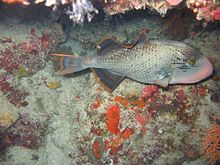Diagnostic Description
provided by Fishbase
Scales relatively large (Ref. 9002).Description: Characterized further by pale snout and cheeks; generally greyish yellow with crosshatch pattern on side; uniform yellow-orange on snout and lower head; median fins with yellow margins; front of eye with deep groove; longitudinal rows of small spines on posterior body 5-6; rounded to emarginate caudal fin (Ref. 90102).
- Recorder
- Cristina V. Garilao
Diseases and Parasites
provided by Fishbase
Caligus Infestation 7. Parasitic infestations (protozoa, worms, etc.)
Life Cycle
provided by Fishbase
Males migrate to a traditional spawning ground where they establish territories enclosing nest sites and egg chambers (Ref. 9777). Nesting occurs in sand-bottomed channels and shallow cuts through the barrier reef (Ref. 9778, 37816). The nest consist of depressions up to 2 m wide and 0.7 m deep (Ref. 9778, 37816). Females arrive several days later and select a male for mating (Ref. 9777). Exhibit biparental care (Ref. 9777). Up to 430,000 or more eggs may be deposited in a spongy fist-sized cluster weighted down with pieces of rubble (Ref. 9778, 37816). Males establish a territory for spawning and parental care but not for feeding (Ref. 116451). Only females tend the eggs but both parents keep guard (Ref. 116451).
Morphology
provided by Fishbase
Dorsal spines (total): 3; Dorsal soft rays (total): 24 - 27; Analspines: 0; Analsoft rays: 22 - 25
- Recorder
- Cristina V. Garilao
Biology
provided by Fishbase
Inhabits coastal to inner reefs and estuaries, often in silty habitats (Ref. 48637). Found on lagoon slope and floor (Ref. 30573), also coral reefs. Generally solitary or in pairs (Ref. 4420). Young form small aggregations when common while adults are usually seen solitary, except when nesting and males congregate on certain sand flats adjacent to reefs (Ref. 48637). Feeds on tips of coral branches, gastropods, crustaceans, foraminiferans, and tunicates (Ref. 1602) and also on sea urchins (Ref. 9770). Oviparous (Ref. 205). Nest-guarding females are aggressive (Ref. 9770). Also caught with drive-in nets. Marketed fresh and dried-salted (Ref. 9770). Ciguatoxic in certain areas (Ref. 37816).
- Recorder
- Estelita Emily Capuli
Importance
provided by Fishbase
fisheries: commercial; aquarium: commercial
- Recorder
- Estelita Emily Capuli
分布
provided by The Fish Database of Taiwan
分布於印度-太平洋區,西起紅海、非洲東岸,東至土木土群島,北至日本南部,南至薩摩亞。台灣除小琉球及澎湖外,皆有分布。
利用
provided by The Fish Database of Taiwan
通常以陷阱法、潛水或流刺網捕獲,以生鮮或醃製於市場出售,因食物鰱的關係,食之可能引起中毒。或以其可愛的模樣而常被飼養於水族館中,供人欣賞。
描述
provided by The Fish Database of Taiwan
體稍延長,呈長橢圓形,
尾柄短。口端位,齒白色,齒上緣皆具缺刻。眼前鼻孔下具一楔形深溝。吻前半部無鱗片,後半部覆有比體鱗小之鱗片;頰部具數條水平的淺溝;鰓裂後有大型骨質鱗片;尾柄具5-6行小棘列。背鰭兩個,基底相接近,第一背鰭位於鰓孔上方,第I棘粗大,第II棘則細長,第III背鰭棘明顯,背鰭及臀鰭軟條同形,前部不較後部高;尾鰭新月形。
體色黃褐色;體與尾部之每一鱗片具一深綠色點。第一背鰭黃色,第二背鰭與臀鰭深綠色,鰭緣橙色;胸鰭綠色,具橙邊;尾鰭深綠色,具橙邊。
棲地
provided by The Fish Database of Taiwan
主要棲息於潟湖區及珊瑚礁區,一般被發現於水深50公尺內的水域,通常獨自或成對活動。以底棲生物為食,包括水螅體、海膽、被囊動物、小型甲殼類等。
Yellowmargin triggerfish
provided by wikipedia EN

Pseudobalistes flavimarginatus
The yellowmargin triggerfish, pineapple trigger, yellowface triggerfish or yellow-face triggerfish (Pseudobalistes flavimarginatus) is a marine fish in the family Balistidae. It is found in coastal tropical waters and reefs of the Indo-Pacific from the Red Sea south to Natal, South Africa and east from southern Japan south to Indonesia, Philippines and Samoa, at water depths from 2–50 m (6.6–164.0 ft).[1]
This triggerfish can grow to a maximum length of 60 cm (24 in). They are marketed either fresh or dried for food, but are potentially dangerous in some areas due to ciguatera poisoning.
The yellowmargin triggerfish is oviparous, spawning in pairs. The female fish guards the nests aggressively. When not mating, this fish is solitary or may remain in pairs.
See also
References
- Froese, Rainer, and Daniel Pauly, eds. (2005). Pseudobalistes flavimarginatus in FishBase. May 2005 version.
- Myers, R.F., 1991. Micronesian reef fishes. Second Ed. Coral Graphics, Barrigada, Guam. 298 p

- license
- cc-by-sa-3.0
- copyright
- Wikipedia authors and editors
Yellowmargin triggerfish: Brief Summary
provided by wikipedia EN

Pseudobalistes flavimarginatus
The yellowmargin triggerfish, pineapple trigger, yellowface triggerfish or yellow-face triggerfish (Pseudobalistes flavimarginatus) is a marine fish in the family Balistidae. It is found in coastal tropical waters and reefs of the Indo-Pacific from the Red Sea south to Natal, South Africa and east from southern Japan south to Indonesia, Philippines and Samoa, at water depths from 2–50 m (6.6–164.0 ft).

Yellowmargin triggerfish at
Apo Reef,
Philippines This triggerfish can grow to a maximum length of 60 cm (24 in). They are marketed either fresh or dried for food, but are potentially dangerous in some areas due to ciguatera poisoning.
The yellowmargin triggerfish is oviparous, spawning in pairs. The female fish guards the nests aggressively. When not mating, this fish is solitary or may remain in pairs.
- license
- cc-by-sa-3.0
- copyright
- Wikipedia authors and editors
Description
provided by World Register of Marine Species
Generally occurs solitarily or in pairs in coral reefs. Feeds on tips of coral branches, gastropods, crustaceans, foraminiferans, and tunicates (Ref. 1602) and also on sea urchins (Ref. 9770). Nest-guarding females are aggressive (Ref. 9770). Also caught with drive-in nets. Marketed fresh and dried-salted (Ref. 9770).
Froese, R. & D. Pauly (Editors). (2023). FishBase. World Wide Web electronic publication. version (02/2023).
- license
- cc-by-4.0
- copyright
- WoRMS Editorial Board


 Pseudobalistes flavimarginatus
Pseudobalistes flavimarginatus  Yellowmargin triggerfish at Apo Reef, Philippines
Yellowmargin triggerfish at Apo Reef, Philippines